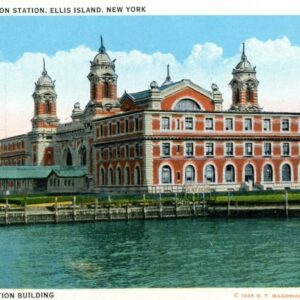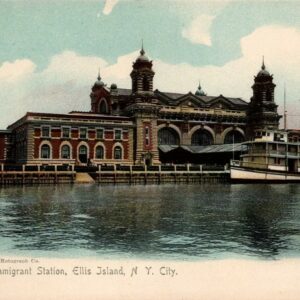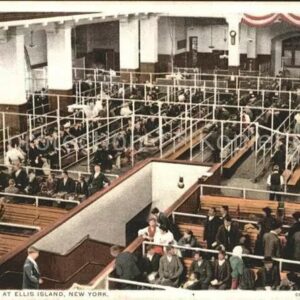
Ellis Island, a small island in New York Harbor, has become a powerfully evocative symbol of immigration to the United States over the years. Before its opening, immigrants disembarked primarily at Castle Garden, but the increase in immigration necessitated a new facility in 1892. Ellis Island quickly became the gateway for more than 12 million people between 1892 and 1954. Every day, thousands of people from all over the world arrived with dreams of freedom and opportunity, hoping to build a new life in America.
The Structure of Ellis Island
Ellis Island was equipped with facilities designed to handle the large influx of immigrants. It included large waiting rooms, registration offices, and even medical areas.
The Registration Process
Upon arrival at Ellis Island, immigrants were subjected to a lengthy and detailed registration process. Once disembarked, immigrants were met by immigration officers who would perform the following procedure:
1. Medical Inspection: Every immigrant had to first go through a medical examination. Doctors checked for signs of contagious diseases, such as tuberculosis and scabies. Immigrants who showed signs of disease or worrisome physical condition were often isolated and, in some cases, sent back.
2. Interview and Recording: After the medical examination, immigrants were asked to answer a series of questions to record their information. Immigration officers asked for details such as their name, age, country of origin, occupation, and reasons for moving to the United States. This process was essential for collecting data and monitoring immigration.
3. Legal Checks: After registration, checks were carried out to ensure that immigrants had no criminal records or other legal grounds that might preclude their entry into the country. Anyone found to be in possession of false documents or had a criminal record risked being turned away.
Release or Detention: Immigrants who passed all stages of the process were eventually released and allowed to enter the United States. However, those who failed inspection were detained at Ellis Island, and in some cases, sent back to their country of origin.
The Debarkation Lists
As the checks progressed, disembarkation lists were compiled: known as “Passenger Arrival Lists” or “Immigration Manifests” or “Ship Manifests”, they were created to record the arrival of immigrants and ensure compliance with immigration laws. These documents were essential for the control of public health and national security, but also for the collection of statistical data on migratory flows.
Structure of the Lists
Ellis Island records followed a rigorous and systematic structure. The main categories of information found on them are listed below:
Destination Data: First Name, Last Name, Age, Gender, Marital Status (single or married).
Place of Origin: Country of Origin, Geographic Area, Specific Place of Origin.
Family Information: If the immigrant was traveling with family members, their names and relationship (spouse, child, or sibling…) were also recorded. Family members were also subjected to subsequent health checks.
Travel Details: Name of Ship, Date of Departure, Date of Arrival.
Health Conditions: After undergoing health checks, any illnesses, scars, deformities, or mutilations were noted.
Destination: Address in the United States: It was common to record where immigrants intended to reside upon arrival.
Contacts: Information about any contacts or family members already in the United States.
Importance of Ellis Island Records
Ellis Island Records are essential sources for genealogy and historical research. They allow descendants of immigrants to trace their family origins and understand the experiences of their ancestors. They also offer unique insight into the social, economic, and cultural dynamics of the time.
Ellis Island Today
Today, Ellis Island National Historic Site is home to the Immigration Museum, which houses the Passenger Lists. The archive is open to the public and offers resources for genealogical research. Through the digitization of documents, immigrant stories have become more accessible and can be explored by anyone who wants to learn more about their family roots.
Conclusions
The Ellis Island Museum tells the story of millions of people from around the world who have sought to realize their “American Dream,” a symbol of hope and resilience for all who have passed through its gates. The immigration registration process at Ellis Island represents a pivotal moment not only in the lives of individuals, but in the formation of the American nation. Thanks in part to what immigrants have accomplished in their new homeland, the American Dream lives on, inspiring new generations to this day.
If you too are looking for the passenger lists of your ancestors who emigrated to America, or want to entrust us with your genealogical research, CONTACT US!
Some old Ellis Island postcards:

 Italiano
Italiano 























